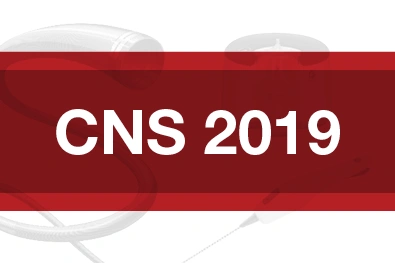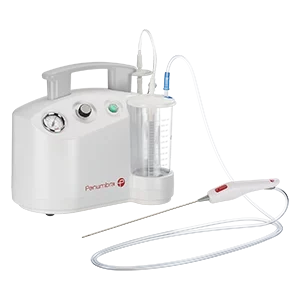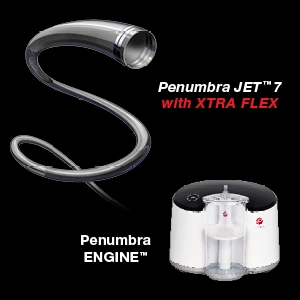Meetings & Events: Penumbra Announces Participation at CNS 2019

Penumbra Announces Its Participation at the 2019 Congress of Neurological Surgeons (CNS) Annual Meeting
Penumbra, Inc. is pleased to announce its participation at the 2019 Congress of Neurological Surgeons (CNS) Annual Meeting to be held October 19-23 at the Moscone Convention Center in San Francisco, CA.
Attendees are invited to learn about Penumbra’s products by visiting Penumbra Booth 637 in Exhibit Hall on the following dates:
- Monday, October 21, 9:30 a.m. to 4:00 p.m.
- Tuesday, October 22, 9:30 a.m. to 3:00 p.m.
- Wednesday, October 23, 9:30 a.m. to 2:00 p.m.
The Artemis™ Neuro Evacuation Device, Penumbra JET™ 7 with XTRA FLEX, and Penumbra ENGINE™ will be featured during the following breakout session:
- Symposium III SYM10: Experience New Stroke Technology with Penumbra
Sunday, October 20, 2:00 to 2:30 p.m.
Moscone Center, Room 3016
About Penumbra’s Neuro Products
The Artemis Neuro Evacuation Device is intended for the controlled aspiration of tissue and/or fluid from the Ventricular System and/or Cerebrum. The Artemis Device works in conjunction with a neuroendoscope through a 19 F (6 mm) sheath. Artemis is a minimally invasive surgical tool that utilizes Pump MAX™ for powerful and controlled hematoma evacuation.

Overview:
- Powerful and controlled aspiration with nearly pure vacuum (-29 inHg or 98.2 kPa)
- 14 mm burr hole with 19 F sheath for minimally invasive cranial access
- Compatible with nueroendoscope for working channels 1.6 — 2.9 mm
- Recessed bident at distal tip maintains cannula patency and aspiration
The Penumbra System is a fully integrated system designed specifically for mechanical thrombectomy by aspiration that first received 510(k) clearance by the U.S. Food & Drug Administration in December 2007.

The Penumbra System enables physicians to use aspiration, which acts like a minimally invasive “vacuum” inside the artery to remove stroke-causing blood clots from the brain safely and effectively. It is intended for use in the revascularization of patients with acute ischemic stroke secondary to intracranial large vessel occlusion. The latest generation of the Penumbra System features the Penumbra JET 7 with XTRA FLEX technology and Penumbra JET D Reperfusion Catheters, the 3D Revascularization Device™, and Penumbra ENGINE and accessories. The Penumbra System includes the new Penumbra JET 7 Reperfusion Catheter with XTRA FLEX technology powered by the Penumbra ENGINE, offering the highest thrombus removal force for revascularization of acute ischemic stroke patients with large vessel occlusions.a Thrombus removal is calculated based on catheter tip size and vacuum level of the aspiration source.
a. Data on file at Penumbra, Inc.
Risk Information
Caution: Federal (USA) law restricts these devices to sale by or on the order of a physician. Prior to use, please refer to the Instructions for Use for complete product indications, contraindications, warnings, precautions, potential adverse events, and detailed instructions for use.
ARTEMIS Neuro Evacuation Device – Indication for Use
The ARTEMIS Neuro Evacuation Device is used for the controlled aspiration of tissue and/or fluid during surgery of the Ventricular System or Cerebrum in conjunction with a Penumbra Aspiration Pump.
Penumbra Aspiration Pump
The Penumbra Aspiration Pump is indicated as a vacuum source for the Penumbra Aspiration Systems.
Contraindications
• The ARTEMIS Neuro Evacuation Device is not recommended during surgery of the brainstem, cerebellum, epidural or subdural spaces.
• Do not use fibrinolytic therapy during the procedure.
• Do not use the ARTEMIS Neuro Evacuation Device with a non-Penumbra recommended Aspiration Pump. The safety and effectiveness of its use with a non Penumbra recommended Aspiration Pump has not been established and can lead to patient injury or death.
Warnings
• The ARTEMIS Neuro Evacuation Device should only be used by physicians who have received appropriate training to perform image-guided neurosurgical procedures.
Precautions
• The ARTEMIS Neuro Evacuation Device is intended for single use only. Do not resterilize or reuse. Resterilization or reuse could lead to infection or ineffective removal of tissue and/or fluid.
• Do not use kinked or damaged devices. Do not use open or damaged packages. Return damaged devices and packaging to the manufacturer/distributor.
• Use prior to the “Use By” date.
• Use the ARTEMIS Neuro Evacuation Device in conjunction with intraprocedural image-guidance.
• Do not use in an oxygen rich environment.
• Do not advance or use the ARTEMIS Neuro Evacuation Device against resistance without careful visual assessment of the cause. If the cause cannot be determined, withdraw the device. Unrestrained torqueing or forced insertion of the device against resistance may result in damage to the device, which may lead to tissue damage and/or device breakage.
Potential Adverse Events
Possible complications include, but are not limited to, the following:
hematoma expansion, fever, headaches, vomiting, hyperglycemia, edema, re-bleeding, death, bleeding, increased blood pressure, infections, seizures, intraventricular hemorrhage, hydrocephalus, thromboembolic events, decreased consciousness, craniotomy, unintended removal of tissue leading to neurological and/or sensory deficit.
Penumbra Pump MAX – Indication for Use
The Penumbra Pump MAX is indicated as a vacuum source for the Penumbra Aspiration Systems.
Contraindications
There are no contraindications.
Warnings/Precautions
• The canister/tubing is intended for single use only. Do not reuse. Reuse may result in canister cracking or tubing blockages, which may result in the inability to aspirate.
• Do not block bottom or back air vents. Unit may overheat and shut off or fail to restart if run for extended periods of time without airflow.
• To avoid risk of electric shock, this equipment must only be connected to a supply mains with protective earth.
• Do not position the pump so that it is difficult to operate the power cord disconnection device.
• Remove and service the pump if liquids or solids have been drawn into the vacuum pump.
• Do not use in the presence of a flammable anaesthetic mixture with air or nitrous oxide.
• Do not use in oxygen rich environment.
• To prevent fire or shock hazard, use replacement fuses of equal size and rating.
• To prevent fire or shock hazard, use a replacement power cord of equal rating.
• Do not re-infuse blood or fluid from the canister back into patient.
• Do not use petroleum base compounds, acids, caustics, or chlorinated solvents to clean or lubricate any parts. It will reduce the service life of the pump. Use only water-base solvents for cleaning.
• Federal (USA) law restricts this device to sale by or on the order of a physician.
• No modification of this equipment is allowed.
PENUMBRA SYSTEM — Indication for Use
Penumbra Reperfusion Catheters and Separators
As part of the PENUMBRA SYSTEM, the Reperfusion Catheters and Separators are indicated for use in the revascularization of patients with acute ischemic stroke secondary to intracranial large vessel occlusive disease (within the internal carotid, middle cerebral — M1 and M2 segments, basilar, and vertebral arteries) within 8 hours of symptom onset. Patients who are ineligible for intravenous tissue plasminogen activator (IV t-PA) or who fail IV t-PA therapy are candidates for treatment.
Penumbra 3D REVASCULARIZATION DEVICE
As part of the PENUMBRA SYSTEM, the Penumbra 3D REVASCULARIZATION DEVICE is indicated for use in the revascularization of patients with acute ischemic stroke secondary to intracranial large vessel occlusive disease (within the internal carotid, middle cerebral — M1 and M2 segments) within 8 hours of symptom onset. Patients who are ineligible for intravenous tissue plasminogen activator (IV t-PA) or who fail IV t-PA therapy are candidates for treatment.
Penumbra Aspiration Tubing
As part of the PENUMBRA SYSTEM, the Penumbra Sterile Aspiration Tubing is indicated to connect the Penumbra Reperfusion Catheters to the Penumbra Aspiration Pump.
Penumbra Aspiration Pump
The Penumbra Aspiration Pump is indicated as a vacuum source for Penumbra Aspiration Systems.
Contraindications
There are no known contraindications.
Warnings
• The device is intended for single use only. Do not resterilize or reuse. Resterilization and/or Reuse may result in ineffective catheter coating lubrication, which may result in high friction and the inability to access the target neuro vasculature location.
• Do not use kinked or damaged devices. Do not use open or damaged packages. Return all damaged devices and packaging to the manufacturer/distributor.
• Do not use automated high-pressure contrast injection equipment with the Penumbra Reperfusion Catheter because it may damage the device.
• Confirm vessel diameter, and select an appropriate size Penumbra Reperfusion Catheter. Do not use in arteries with diameters smaller or equal to the distal outer diameter of the Penumbra Reperfusion Catheters. Refer to the Reperfusion Catheter labeling for dimensional information.
• Do not advance, retract or use any component of the PENUMBRA SYSTEM against resistance without careful assessment of the cause using fluoroscopy. If the cause cannot be determined, withdraw the device or system as a unit. Unrestrained torquing or forced insertion of the catheter, revascularization device, or separator against resistance may result in damage to the device or vessel.
• Do not use the PENUMBRA SYSTEM with a pump other than the Penumbra Aspiration Pump.
• The Penumbra 3D REVASCULARIZATION DEVICE has not been evaluated in patients with angiographic evidence of pre-existing arterial injury.
Precautions
• The PENUMBRA SYSTEM should only be used by physicians who have received appropriate training in interventional neuro-endovascular techniques and treatment of acute ischemic stroke.
• Use prior to the “Use By” date.
• Use the PENUMBRA SYSTEM in conjunction with fluoroscopic visualization.
• As in all fluoroscopy procedures, consider all necessary precautions to limit patient radiation exposure by using sufficient shielding, reducing fluoroscopy times and modifying radiation technical factors whenever possible.
• Maintain a constant infusion of appropriate flush solution.
• When performing aspiration, ensure that the Penumbra Aspiration Tubing valve is open for only the minimum time needed to remove thrombus. Excessive aspiration or failure to close the Penumbra Aspiration Tubing valve when aspiration is complete is not recommended.
• The Penumbra SEPARATOR is not intended for use as a neurovascular guidewire. If repositioning of the Penumbra Reperfusion Catheter is necessary during the revascularization procedure, such repositioning should be performed over an appropriate neurovascular guidewire using standard microcatheter and guidewire techniques.
• Administration of anticoagulants and antiplatelets should be suspended until 24 hours post-treatment. Medical management and acute post stroke care should follow the ASA guidelines.1 Any neurological deterioration should be evaluated by urgent CT scan and other evaluations as indicated according to investigator/hospital best practice.
• As in all surgical interventions, monitoring of intra-procedural blood loss is recommended so that appropriate management may be instituted.
Potential Adverse Events
Possible complications include, but are not limited to, the following:
allergic reaction and anaphylaxis from contrast media; acute occlusion; air embolism; arteriovenous fistula; death; device malfunction; distal embolization; emboli; false aneurysm formation; hematoma or hemorrhage at access site; inability to completely remove thrombus; infection; intracranial hemorrhage; ischemia; kidney damage from contrast media; neurological deficits including stroke; vessel spasm, thrombosis, dissection, or perforation; radiation exposure that may lead to cataracts, skin reddening, burns, alopecia, or neoplasia from x-ray exposure.
1. Adams, et al., Guidelines for the Early Management of Adults with Ischemic Stroke: A Guideline from the AHA/ASA Stroke Council, Clinical Cardiology Council, Cardiovascular Radiology and Intervention Council, and the Atherosclerotic Peripheral Vascular Disease and Quality of Care Outcomes in Research Interdisciplinary Working Groups: The American Academy of Neurology affirms the value of this guideline as an educational tool for neurologists, Stroke May 2007; 38:1655-1711.
PENUMBRA ENGINE — Indication for Use
The PENUMBRA ENGINE is indicated as a vacuum source for Penumbra Aspiration Systems.
Contraindications
There are no contraindications.
Warnings/Precautions
• The canister is intended for single use only. Do not reuse. Reuse may result in canister cracking or vacuum filter blockages, which may result in the inability to aspirate.
• Do not block bottom or back air vents. Unit may overheat and shut off or fail to restart if run for extended periods without airflow.
• To avoid risk of electrical shock, this equipment must only be connected to a supply mains with protective earth.
• Do not position the PENUMBRA ENGINE so that it is difficult to remove the power cord. The means of mains disconnect is to remove the power cord.
• Only use replacement fuse with correct rating (see Table 1 for fuse rating).
• Remove and service the PENUMBRA ENGINE if liquids or solids have been drawn into the PENUMBRA ENGINE.
• Do not use in the presence of a flammable anesthetic mixture with air or nitrous oxide.
• Do not use in an oxygen rich environment.
• To prevent fire or shock hazard, use a replacement power cord of equal rating.
• Do not re-infuse blood or fluid from the canister back into the patient.
• Do not use petroleum base compounds, acids, caustics, or chlorinated solvents to clean or lubricate any parts. It will reduce service life of the PENUMBRA ENGINE. Use only water-based solvents for cleaning.
• Use of this equipment adjacent to or stacked with other equipment should be avoided because it could result in improper operation. If such use is necessary, this equipment and the other equipment should be observed to verify that they are operating normally.
• Portable RF communications equipment (including peripherals such as antenna cables and external antennas) should be used no closer than 30 cm (12 inches) to any part of the PENUMBRA ENGINE.Otherwise, this could result in degradation of the performance of this equipment.
• Common emitters (such as RFID emitters, security systems, diathermy equipment, and portable transmitters) should not be used in close proximity to the PENUMBRA ENGINE as they can interfere with and result in degradation of the performance of the equipment.
• Equipment is not safe for MR use.
• No modification of this equipment is allowed.
Related Articles
-
Employee Spotlight: Pascual Reginio
June 26, 2025 -
Penumbra’s Newly Expanded swiftPAC™ Coil Line Poised to Help Physicians Meet Growing Demand for Neurosurgical Conditions
June 20, 2025 -
New THRIVE Data Demonstrates Penumbra’s CAVT™ Technology Is Associated with Reduced Related Readmissions and Complication Rates When Managing ALI
June 6, 2025 -
Employee Spotlight: Maria R. Contreras
May 29, 2025
